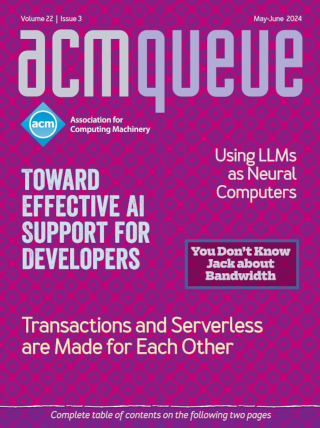
Distributed Development: Lessons Learned:
Why repeat the mistakes of the past if you don’t have to?
Delivery of a technology-based project is challenging, even under well-contained, familiar circumstances. And a tight-knit team can be a major factor in success. It is no mystery, therefore, why most small, new technology teams opt to work in a garage (at times literally). Keeping the focus of everyone’s energy on the development task at hand means a minimum of non-engineering overhead.
Black Box Debugging:
It’s all about what takes place at the boundary of an application.
Modern software development practices build applications as a collection of collaborating components. Unlike older practices that linked compiled components into a single monolithic application, modern executables are made up of any number of executable components that exist as separate binary files. This design means that as an application component needs resources from another component, calls are made to transfer control or data from one component to another. Thus, we can observe externally visible application behaviors by watching the activity that occurs across the boundaries of the application’s constituent components.
The Sun Never Sits on Distributed Development:
People around the world can work around the clock on a distributed project, but the real challenge lies in taming the social dynamics.
More and more software development is being distributed across greater and greater distances. The motives are varied, but one of the most predominant is the effort to keep costs down. As talent is where you find it, why not use it where you find it, rather than spending the money to relocate it to some ostensibly more "central" location? The increasing ubiquity of the Internet is making far-flung talent ever-more accessible.
A Conversation with Steve Hagan:
At Oracle, distributed development is a way of life.
Oracle Corporation, which bills itself as the world’s largest enterprise software company, with $10 billion in revenues, some 40,000 employees, and operations in 60 countries, has ample opportunity to put distributed development to the test. Among those on the front lines of Oracle’s distributed effort is Steve Hagan, the engineering vice president of the Server Technologies division, based at Oracle’s New England Development Center in Nashua, New Hampshire, located clear across the country from Oracle’s Redwood Shores, California, headquarters.
Building Collaboration into IDEs:
Edit>Compile>Run>Debug>Collaborate?
Software development is rarely a solo coding effort. More often, it is a collaborative process, with teams of developers working together to design solutions and produce quality code. The members of these close-knit teams often look at one another’s code, collectively make plans about how to proceed, and even fix each other’s bugs when necessary. Teamwork does not stop there, however. An extended team may include project managers, testers, architects, designers, writers, and other specialists, as well as other programming teams. Programmers also interact with the community of developers outside their organization to obtain advice, code snippets, and a general understanding of what works and what doesn’t.
Culture Surprises in Remote Software Development Teams:
When in Rome doesn’t help when your team crosses time zones, and your deadline doesn’t.
Technology has made it possible for organizations to construct teams of people who are not in the same location, adopting what one company calls "virtual collocation." Worldwide groups of software developers, financial analysts, automobile designers, consultants, pricing analysts, and researchers are examples of teams that work together from disparate locations, using a variety of collaboration technologies that allow communication across space and time.
Sink or Swim: Know When It’s Time to Bail:
A diagnostic to help you measure organizational dysfunction and take action
There are endless survival challenges for newly created businesses. The degree to which a business successfully meets these challenges depends largely on the nature of the organization and the culture that evolves within it. That’s to say that while market size, technical quality, and product design are obviously crucial factors, company failures are typically rooted in some form of organizational dysfunction. To help investors recognize signs of trouble before catastrophe strikes, I started working more than a decade ago on the Bell-Mason Diagnostic, a quantitative evaluation method that includes a set of rules for examining a company and comparing it with an “ideal” organization.
The Economics of Spam:
Who pays in the spam game?
You know what I hate about spam filtering? Most of what we do today hurts the people who are already being hurt the most. Think about it: Who pays in the spam game? The recipients. That’s what’s wrong in the first place - the wrong folks pay for this scourge.





